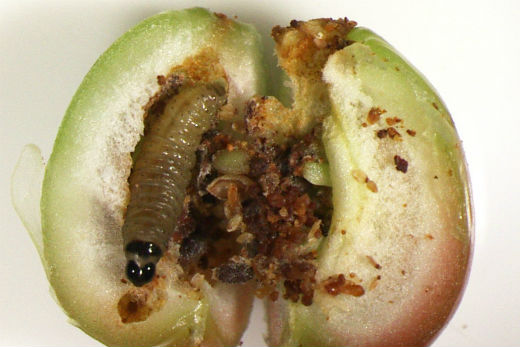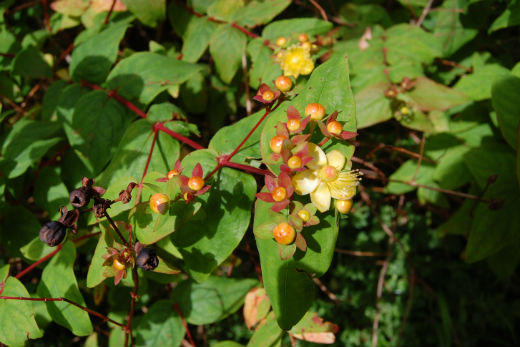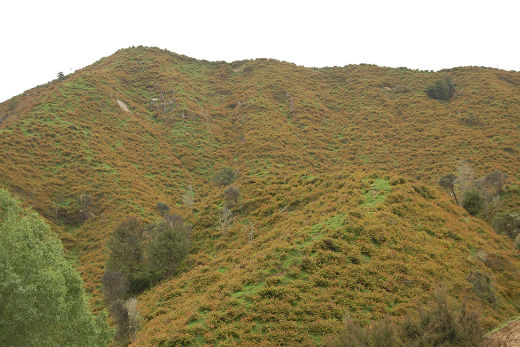|
The Environmental Protection Authority has enlisted the help of a moth and a beetle to get rid of a highly visible and widespread weed in the central North Island. Considered a serious agricultural and environment pest in the central North Island Tutsan (Hypericum androsaemum) is a yellow-flowering shrub introduced into New Zealand as a garden plant in the 1800s.
By 1924, tutsan had grown out of control and has been a growing threat to hill country farming since the 1950s. It thrives in the central North Island, particularly around stream margins and regenerating scrub. In some areas, such as the Waikato, landowners work with their regional councils to control the weed. Although it's not toxic, livestock will not eat it and removing it is time consuming: even minor infestations require intensive effort and herbicides are usually used to control or reduce larger infestations.
As a result, tutsan cannot be bought, sold, propagated, distributed or included in commercial displays. Now the Authority has approved the use of two biocontrol agents: a moth and a leaf-feeding beetle to help in the fight to combat the weed.
The larvae of the moth (Lathronympha strigana) feed on the leaves and stems of the plant in spring and burrow into the fruit, consuming its seeds.
The leaf beetle larvae (Chrysolina abchasica), in large enough numbers, are capable of stripping the plant of its leaves says Environmental Protection Authority acting general manager of hazardous substances and new organisms Ray McMillan. 'Using biological control agents, or nature's enemies, is a cost-effective way of targeting and reducing the impact of pest plants such as tutsan without resorting to chemicals. 'Tutsan is a significant problem throughout New Zealand and is a threat to native plants and hill country farming.” Ray says using biological control agents as part of their weed management strategy will provide a cheaper alternative for landowners and councils. 'And releasing two biological control agents with complementary feeding habits increases their effectiveness. If they both establish successfully and disperse widely they'll increase the chance of success of the biocontrol programme.” |
Posted: 06:11pm Wed 18 May, 2016 | By Greg Taipari greg@thesun.co.nz
Bug off weed

19-Apr 07:30
Black Falcons to end season with flypast
19-Apr 07:00
A paws-itively amazing career in animal services
19-Apr 06:45
NZ caught up in worldwide phishing sting
19-Apr 06:30
Coffee cup thrown at Tauranga café worker
18-Apr 20:00
AirNZ passenger breaks leg flying Bali to Auckland
18-Apr 19:00
Earthquake-prone buildings review brought forward
18-Apr 18:20
Pyes Pa Road closure following crash
18-Apr 18:00
Infant pilot whale washes up at Ōhope Beach
18-Apr 17:41
Crash at Cameron road intersection
18-Apr 17:30
Road closed, SH1 Taupō
18-Apr 17:00
Zespri poised for strong season in China
18-Apr 16:00
The app helping older people gain independence
OPINION POLL
Where should Tauranga CBD's permanent bus stop be located?
LATEST JOBS
Fed up of your kiwifruit job? Work on the Port $22
Our client is looking for crew members to join the team and learn the skill of stevedoring! This role requires crew members...
View or Apply on GoodWork.co.nz
Asphalt Road Assistant
We have an immediate opportunity for you to join a civil company; within the asphalt division.Your role will involve:* Ground...
View or Apply on GoodWork.co.nz
Accounts Payroll Administrator
Join New Zealand’s Award Winning recruitment team! We have an exciting opportunity for an Accounts / Payroll superstar...
View or Apply on GoodWork.co.nz
Frozen Fish Packers
We urgently need frozen fish packers. This is working between 2 to 5 days a week.Day shift only.This role will involve:*...
View or Apply on GoodWork.co.nz
Earth works labourer
We are on the hunt for labourers to join a busy construction company located in the Bay of Plenty. You will enjoy hard work...
View or Apply on GoodWork.co.nz
Traffic Control worker
We have full time positions screaming for qualified traffic controllers. You must have your TC ticket however no experience...
View or Apply on GoodWork.co.nz
Service Technician
Our Client based in Tauranga is dedicated to delivering world class material handling solutions, with a heritage unrivalled...
View or Apply on GoodWork.co.nz
Digger Operator 7am to 7pm - ASAP START IN BAYFAIR
We are seeking a hard working and reliable machine operator to work as a digger operator on a locally based project until...
View or Apply on GoodWork.co.nz
Administrator
We are looking for a highly organised Administrator for our large nationwide client.You will be responsible for providing...
View or Apply on GoodWork.co.nz
Fire Installer/Chimney Sweeper
Are you an experienced tradesman, perhaps a plumber or roofer looking for a new and exciting opportunity? We are on the hunt...
View or Apply on GoodWork.co.nz
Truck driver wanting a change
The civil season is about to kick off here in Tauranga and we have positions for 2 class 2 truck drivers who would be interested...
View or Apply on GoodWork.co.nz
Finish Department Assembler
Our Client is looking for an Assembler for their finishing department. This role is based in Tauranga and will be an immediate...
View or Apply on GoodWork.co.nz
Fencing Labourer
Are you looking for the next step in your career? Either experienced in the landscape industry or willing to learn, this...
View or Apply on GoodWork.co.nz
Experienced Spray Painter or Trainee
Experienced Spray Painter & TraineeID: 94995Permanent position (2 Roles)Immediate start RotoruaBay of Plenty Are You A Heavy...
View or Apply on GoodWork.co.nz
Senior Planner
We're seeking an experienced Senior Planner for a full-time position in the Bay of Plenty. Ideally, you should have at least...
View or Apply on GoodWork.co.nz
Part Time Cleaner - 5pm to 7pm
Part Time Commercial Cleaner needed in Mount Maunganui.The hours will be Monday to Friday - 5pm to 7pmOur client is looking...
View or Apply on GoodWork.co.nz
Log Labeller trainee
two full time Logging Assistants required for an on going position based on Tauranga Port. This role includes - * Stapling...
View or Apply on GoodWork.co.nz
Factory machine operator - 47 hours per week
Our client is needing reliable and hard working candidates to take on their machine operating role based in Tauriko. Previous...
View or Apply on GoodWork.co.nz
Traffic Control worker
We have full time positions screaming for qualified traffic controllers. You must have your TC ticket however no experience...
View or Apply on GoodWork.co.nz
Advanced Labourer.
Gardener required to assist with the maintenance of commercial sites.Great opportunity to work outside and check out different...
View or Apply on GoodWork.co.nz
Landscape Labourer - start a new career
Labourer needed for landscape team. This job is starting immediately.Full training provided.Work ranges from maintenance...
View or Apply on GoodWork.co.nz
Builder
Our client, a residential construction company located in the Bay of Plenty are looking for builders who have 'done their...
View or Apply on GoodWork.co.nz
Trades Supervisor
Our client, a well-known trades and building supplies company is on the lookout for a passionate leader for the trades team...
View or Apply on GoodWork.co.nz
Class 2 Driver - no experience needed!!
On behalf of our client, we are on the hunt for Class 2 Drivers to drive a variety of different trucks. Experience is not...
View or Apply on GoodWork.co.nz
Green Spaces Labourer - full training provided
Work is available with a large civil company in their Green Spaces team, mowing commercial lawns, gardening, weed eating...
View or Apply on GoodWork.co.nz
Factory cleaner no experience needed
Mount Maunganui based factory are putting together a team of commercial cleaners to clean down the factory at the end of...
View or Apply on GoodWork.co.nz
Factory Workers - $20 - $22ph
We have a number of clients requiring Factory Workers around the Mount Maunganui & Tauranga areas.These positions are:* Packing*...
View or Apply on GoodWork.co.nz
Class 4 and 5 Drivers
Experienced Class 4 and 5 Drivers for civil sites, metro and line haul jobs.Our client uses modern technology on board trucks...
View or Apply on GoodWork.co.nz
Casual Laundry Worker
You will be a causal Laundry Assistant to join a small, busy team in Tauranga Central. Flexible to cover holiday and sick...
View or Apply on GoodWork.co.nz
Warehouse Coordinator
Our client is in need of an Warehouse Coordinator.This will be a hands-on role, based at the Head Office in Mount Maunganui.Duties...
View or Apply on GoodWork.co.nz





0 comments
Leave a Comment
You must be logged in to make a comment.